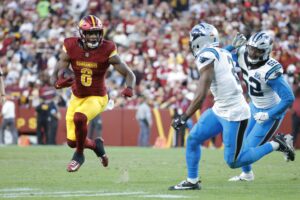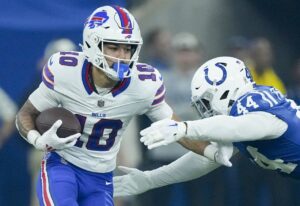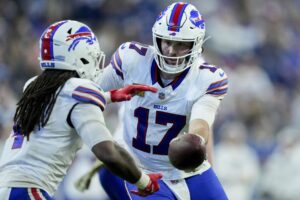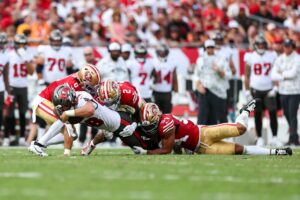It’s been an up and down season for the New Orleans Saints defense, to say the least. It started with a 48-40 loss to the Tampa Bay Buccaneers in which the Saints allowed 417 passing yards and 112 rushing yards. Both figures remain season-highs. Two weeks later, they gave up 9.4 yards per pass and 37 points in a shoot-out win over the Atlanta Falcons.
From that point on, however, the overall defensive play improved as players like defensive tackle Sheldon Rankins and linebacker Demario Davis broke out and helped the Saints front seven become a dominant force. The Saints now have the top-ranked run defense in the NFL and are tied for third with 48 sacks.
The arrival of cornerback Eli Apple via trade generally improved the secondary, yet the group has still struggled against high-powered passing attacks. This was evident last Sunday, as Pittsburgh Steelers star receivers Antonio Brown and JuJu Smith-Schuster shredded New Orleans for 300 yards and two touchdowns on 15 receptions.
Overall, the Saints defense is better off then they were in September. However, their strengths and weaknesses are blatantly clear, and their defensive identity could either make or break their Super Bowl aspirations.
New Orleans Saints Defensive Identity Clear as Postseason Approaches
How Much Has the Pass Defense improved?
With one game left to play, the Saints defense has allowed 269.3 passing yards per game and 8.0 yards per pass attempt. Both figures rank 28th among NFL defenses. The overall season numbers don’t tell the entire story though, as they’ve played much better in the second half of the season.
In their first eight games, New Orleans allowed 311.3 passing yards per game, compared to 221.1 passing yards per game in their last seven games. This improvement hasn’t necessarily been the result of lesser competition either.
The Saints played against four top-ten passing offenses in the first half of the season and allowed each of them to gain more than 330 passing yards. They have played four more top ten passing offenses since then. The Falcons and the Steelers both threw for at least 340 yards, however, the Saints impressively kept both Tampa Bay and the Philadelphia Eagles under 175 passing yards.
The good news is that as of now, the Los Angeles Rams and Minnesota Vikings are the only NFC teams with top-ten passing offenses slotted to make the postseason. New Orleans managed to beat both teams by ten points earlier in the season, despite allowing a combined 729 passing yards in those games.
Dangerous Receiver Duos Have Been Problematic
If you’re looking for a pattern, the Achilles heel of the Saints defense seems to be teams with two high-quality wide receivers.
In their week one loss to Tampa Bay, Mike Evans and DeSean Jackson both gained over 140 yards receiving and combined for three touchdowns. Jackson was inactive for the second matchup, allowing New Orleans to key in on Evans and hold him to 86 yards.
Philadelphia struggled against New Orleans despite a talented duo in Nelson Agholor and Alshon Jeffrey, but their passing game is more dependent on tight end Zach Ertz, who has nearly twice as many catches as Agholor and Jeffrey.
Going further down the list, Minnesota Vikings receivers Adam Thielen and Stefon Diggs each gained over 100 receiving yards and caught touchdown passes against the Saints. In a shootout with the Rams, former Saint Brandin Cooks picked up 114 receiving yards and a score, with Cooper Kupp contributing 89 yards and a touchdown. Last month, Falcons receivers Julio Jones and Calvin Ridley combined for 240 yards and a touchdown on 19 receptions.
This makes the Rams and Vikings look even more threatening in January. The Rams lost Kupp for the season, but Robert Woods has stepped up in his place and leads the team in receptions and receiving yards. The Vikings top receivers are still excellent. Thielen’s 110 receptions, 1,335 receiving yards, and nine receiving touchdowns rank eighth or better in each category. Diggs has 94 catches and is set to exceed 1,000 receiving yards next week.
The addition of Apple has helped the Saints handle these types of matchups better, but teams are still opting to target him over Marshon Lattimore. Even if this is problematic, Apple has undoubtedly outperformed previous starter Ken Crawley. He’s one of the defense’s most important components at this point, considering the situation could go from problematic to disastrous if either Lattimore or Apple are injured.
Elite Run Defense a Big Advantage Against NFC Playoff Field
Fans would probably appreciate a more reliable pass defense, but a great run defense may be more valuable in January anyway. Three of the Saints five potential playoff opponents boast top-ten rushing offenses. This includes the league-leading Seattle Seahawks, the third-ranked Rams, and the sixth-ranked Dallas Cowboys.
There’s also the Chicago Bears, who can be dangerous on the ground as well with a 14th-ranked 117.9 yards per game. The Vikings are the only NFC team slotted to make the postseason that’s lacking in this area. They rank 30th with 95.3 rushing yards per game, although they’ve put up a 195-yard and 220-yard rushing performance this season, so the potential is there.
The Saints held both the Rams and Cowboys just under 100 yards rushing. The Rams were pretty successful with 4.8 yards per carry, but had to abandon their run game early as they fell behind. Dallas running back Ezekiel Elliott, on the other hand, managed just 3.3 yards per carry, his second-lowest average of the season. The Vikings were held to 85 rushing yards at 3.9 yards per carry by the Saints.
Overall, the Saints have allowed 100 yards rushing or more just three times this season, and there’s not really a game you can point to where their opponent’s run game was a big factor. This has been a remarkable turnaround for a unit that allowed 100 or more rushing yards in ten games last season, with over 150 yards allowed in three games. This may be the least concerning part of the Saints overall game on either side of the ball.
Outlook
There’s little question about where the Saints defensive strengths and weaknesses lie. A team like the Seahawks or Cowboys, which rely heavily on their run game, could have a hard time being productive on the road against New Orleans. The Vikings or Rams, on the other hand, would likely put up big numbers and force the Saints offense to respond. The prospect of a shootout is scary even in the Superdome, since New Orleans lost a game 48-40 at home in week one, and nearly fell to the Steelers at home.
Fortunately, the Saints defense overall looks more prepared for the postseason this year. Last season, many of the young defensive starters had their first taste of the NFL playoffs and the moment looked too big for them at times. In both 2017 playoff games, the Saints allowed over 400 yards of offense, including over 300 yards passing in each game. Then the season ended with a rookie’s missed tackle that led to the last-second Diggs touchdown against Minnesota.
Having been to the postseason before should instill confidence in the Saints defense. Home-field advantage and a deafening crowd will make life difficult for any offense that enters the Superdome.
Sure, the Saints defense has painfully obvious weaknesses, but their advantages should outweigh their flaws in January.
Main Photo:
Embed from Getty Images






